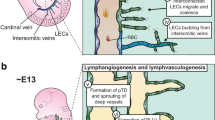Abstract
About 8–9 decades ago the development of embryonic lymphatics was studied intensively. Since then our knowledge has not considerably increased in this field, and it is still unknown whether lymphatics are derived by sprouting from veins, de novo from lymphangioblasts, or by both mechanisms. However, very recent studies have shown that the vascular endothelial growth factor-C (VEGF-C) is a highly specific lymphangiogenic growth factor. This raises new questions and perspectives. Here we will review the literature on embryonic lymphangiogenesis and lymphangiogenic growth factors. We also present a description of the pattern of the lymphatics of avian embryos with emphasis on lymph hearts. The avian embryo is highly suited for studies on lymphatics, because these can be demonstrated by injection methods, serial sectioning and in situ hybridization with VEGF-receptor-2 and -3 probes. The greatest advantage resides in the fact that the lymphatics of the chorioallantoic membrane are easily accessible for experimental studies.
Similar content being viewed by others
Author information
Authors and Affiliations
Additional information
Received: 27 July 1998 / Accepted: 10 November 1998
Rights and permissions
About this article
Cite this article
Wilting, J., Neeff, H. & Christ, B. Embryonic lymphangiogenesis. Cell Tissue Res 297, 1–11 (1999). https://doi.org/10.1007/s004410051328
Issue Date:
DOI: https://doi.org/10.1007/s004410051328




